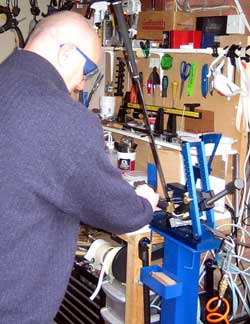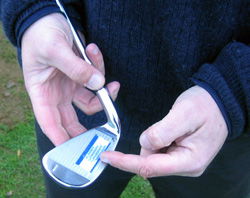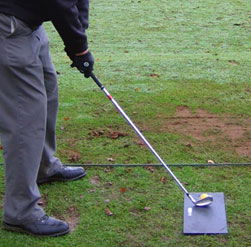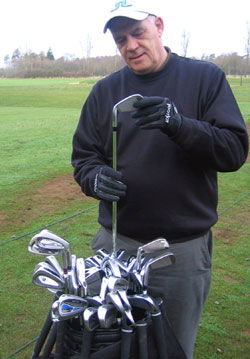Custom-fitting: What you need to know
A simple guide to a club-fit experience

THE GOLF INDUSTRY constantly tells us it's no longer appropriate to choose a golf club 'off the shelf' and buy it, based on a mates' recommendation, a waggle in the shop and a swing in the net by the first tee. And they're dead right. We're all different sizes and shapes, with dissimilar golf abilities and swings as unique as our fingerprint. So it makes sense to have our golf clubs tailored and fitted for us as individuals by a professional expert. As a seasoned golfer, I was asked by Golfmagic.com to head down to one of my local fitters, ask the key questions, come back with some answers and report back on the experience.
Club fitting is matching the specifications of golf clubs to the individual golfer. Think of it as tailoring a bespoke suit. Just as the tailor would make sure the trouser legs aren't too short and the jacket fitted nicely across the shoulders, with golf clubs, they can be fine-tuned to your individual physique and golf swing.
Off-the-shelf golf clubs are manufactured to suit 'Mr Average.' But we're all different shapes and sizes and a club that's unsuitable will be detrimental to your game. You should not need to adjust your swing to accommodate the club. So it is sensible to use clubs that have been fitted for our personal size and needs to optimise our skill set and abilities. The bottom line is: Will it lower lower my scores? For most golfers, properly-fitted clubs will improve performance and lower scores. | |
Whatever their experience or ability, all golfers will benefit from being fitted for equipment - from beginner to low handicapper.
Every club in the bag - from driver to putter. Some fitters recommend starting with the scoring clubs - putter, wedges and short irons - then work through mid-irons, long irons and metalwoods. It's a seductive temptation to start with the driver but the potential gains here, in terms of improvement and reducing your handicap, are smaller than with the scoring clubs. So it's worth giving consideration to having ALL your clubs fitted, not just the ones that give you a particular thrill by being hit further!
Most golf retail outlets now offer a fitting service. However, with some outlets it's something of a token effort. I recommend visiting an independent specialist club-fitter whose field of expertise is club fitting rather than club selling.
A good club fitter will have a professional club fitting qualification. They will have a wealth of experience and positive testimonials from happy customers. Ask to see them. I recommend visiting a fitter that uses an outside hitting area (preferably from grass) rather than just an indoor mat, a net and a launch monitor. Watching your personal ball flight in the cold light of day is an important part of understanding a golfer’s requirements. As with so much in life, seek help in identifying a fitter to suit you from those whose opinion you respect. Ask around and read the related threads on the golfmagic.com forum. | |
Not essential. While the fashionable Launch Monitor (LM) can provide the fitter with additional information such as ball spin rates and trajectory - and in the hands of a good fitter is a useful tool - a professional who uses traditional methods is, in my opinion, every bit as good and may produce better results for your game. How should I prepare for the session? No special preparations are required. Take along your own clubs as a handy guide for the fitter and use them to warm up for your session.
Some facilities charge upto £50 - after all you're using a qualified fitter's facilities, time and expertise - and you may want to take the information learned to purchase a more attractive deal elsewhere. However, mostly I've found that any nominal charge is refundable against a purchase made from that fitter. You might even get a fitting free but ask when you book your session. | |
Your physique tends to determine choice of shaft length and grip size and using a variety of tools and physical measurements, the fitter will determine the key aspects of your required clubs. Fitting tools include a lie board to determine how upright or flat the clubhead needs to be in relation to your height and the way you address the ball. Impact tape on the face of the club will show where you tend strike the ball most consistently and a swing-speed/launch monitor, if available, can measure your swing speed which largely dictates the stiffness of shaft you need. However, a good club fitter will mostly use their experienced eyes and knowledge to make their recommendations.
A good club fitter will spend at least a couple of hours discovering your needs, depending on how many clubs you want fitted. They will usually advise you at the time of booking how long the fitting might take but always allow for extra time, as most fitters are very thorough and want to ensure you're fully satisfied with their service and recommendations.
Don’t despair! Take your time, relax and swing smoothly. That's why it's important to warm-up first. The fitter will be used to golfers being a little nervous and their experience will enable them to see past the poor swings and focus on the ones that more accurately portray their client's normal swing. | |
This depends largely on how suitable your current clubs are for you. A fitter may recommend a small change such as an adjustment of their lie angle - to more flat, neutral or more upright - in which case your current clubs will usually be adjusted for a small charge. If a more radical change is recommended, this can include new shafts, grips or new clubs altogether.
Some fitters will loan demo clubs for you to try as they want you to experience the changes on your regular course, under normal playing conditions and using your preferred ball - as opposed to harder ones on the range. But this isn’t always possible. They tend not to stock too many demo clubs required to cover every variant. You are putting yourself in the hands of the fitter and trusting their skill and judgment.
A good club fitter won't be happy until you're happy! They will tweak and fine-tune them until the clubs are working for you. Once properly fitted you will look back and wonder why you ever struggled with clubs that were unsuited to you. You will gain confidence, play better, score better, and lower your handicap.
IronWRX, based in Hook, Hampshire (user ' rgjusa' on the Golfmagic.com forum) for hosting my club-fitting session. Tell us on the forum about your club-fitting experiences. |






